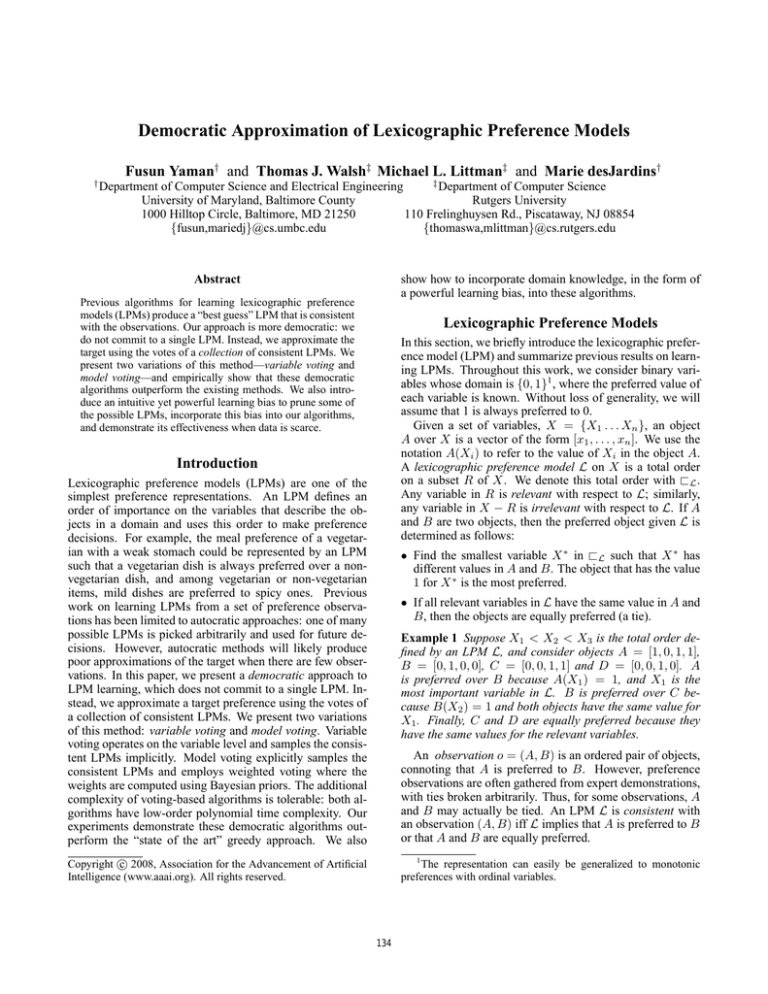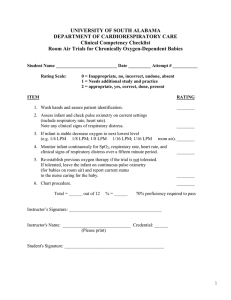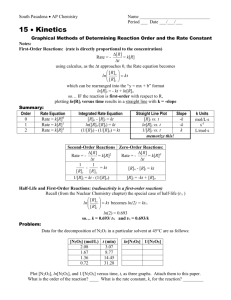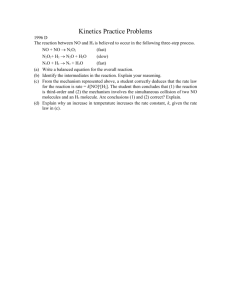
Democratic Approximation of Lexicographic Preference Models
Fusun Yaman† and Thomas J. Walsh‡ Michael L. Littman‡ and Marie desJardins†
†
‡
Department of Computer Science and Electrical Engineering
Department of Computer Science
University of Maryland, Baltimore County
Rutgers University
1000 Hilltop Circle, Baltimore, MD 21250
110 Frelinghuysen Rd., Piscataway, NJ 08854
{fusun,mariedj}@cs.umbc.edu
{thomaswa,mlittman}@cs.rutgers.edu
Abstract
show how to incorporate domain knowledge, in the form of
a powerful learning bias, into these algorithms.
Previous algorithms for learning lexicographic preference
models (LPMs) produce a “best guess” LPM that is consistent
with the observations. Our approach is more democratic: we
do not commit to a single LPM. Instead, we approximate the
target using the votes of a collection of consistent LPMs. We
present two variations of this method—variable voting and
model voting—and empirically show that these democratic
algorithms outperform the existing methods. We also introduce an intuitive yet powerful learning bias to prune some of
the possible LPMs, incorporate this bias into our algorithms,
and demonstrate its effectiveness when data is scarce.
Lexicographic Preference Models
In this section, we briefly introduce the lexicographic preference model (LPM) and summarize previous results on learning LPMs. Throughout this work, we consider binary variables whose domain is {0, 1}1 , where the preferred value of
each variable is known. Without loss of generality, we will
assume that 1 is always preferred to 0.
Given a set of variables, X = {X1 . . . Xn }, an object
A over X is a vector of the form [x1 , . . . , xn ]. We use the
notation A(Xi ) to refer to the value of Xi in the object A.
A lexicographic preference model L on X is a total order
on a subset R of X. We denote this total order with ⊏L .
Any variable in R is relevant with respect to L; similarly,
any variable in X − R is irrelevant with respect to L. If A
and B are two objects, then the preferred object given L is
determined as follows:
Introduction
Lexicographic preference models (LPMs) are one of the
simplest preference representations. An LPM defines an
order of importance on the variables that describe the objects in a domain and uses this order to make preference
decisions. For example, the meal preference of a vegetarian with a weak stomach could be represented by an LPM
such that a vegetarian dish is always preferred over a nonvegetarian dish, and among vegetarian or non-vegetarian
items, mild dishes are preferred to spicy ones. Previous
work on learning LPMs from a set of preference observations has been limited to autocratic approaches: one of many
possible LPMs is picked arbitrarily and used for future decisions. However, autocratic methods will likely produce
poor approximations of the target when there are few observations. In this paper, we present a democratic approach to
LPM learning, which does not commit to a single LPM. Instead, we approximate a target preference using the votes of
a collection of consistent LPMs. We present two variations
of this method: variable voting and model voting. Variable
voting operates on the variable level and samples the consistent LPMs implicitly. Model voting explicitly samples the
consistent LPMs and employs weighted voting where the
weights are computed using Bayesian priors. The additional
complexity of voting-based algorithms is tolerable: both algorithms have low-order polynomial time complexity. Our
experiments demonstrate these democratic algorithms outperform the “state of the art” greedy approach. We also
• Find the smallest variable X ∗ in ⊏L such that X ∗ has
different values in A and B. The object that has the value
1 for X ∗ is the most preferred.
• If all relevant variables in L have the same value in A and
B, then the objects are equally preferred (a tie).
Example 1 Suppose X1 < X2 < X3 is the total order defined by an LPM L, and consider objects A = [1, 0, 1, 1],
B = [0, 1, 0, 0], C = [0, 0, 1, 1] and D = [0, 0, 1, 0]. A
is preferred over B because A(X1 ) = 1, and X1 is the
most important variable in L. B is preferred over C because B(X2 ) = 1 and both objects have the same value for
X1 . Finally, C and D are equally preferred because they
have the same values for the relevant variables.
An observation o = (A, B) is an ordered pair of objects,
connoting that A is preferred to B. However, preference
observations are often gathered from expert demonstrations,
with ties broken arbitrarily. Thus, for some observations, A
and B may actually be tied. An LPM L is consistent with
an observation (A, B) iff L implies that A is preferred to B
or that A and B are equally preferred.
1
The representation can easily be generalized to monotonic
preferences with ordinal variables.
c 2008, Association for the Advancement of Artificial
Copyright Intelligence (www.aaai.org). All rights reserved.
134
Algorithm 1 greedyPermutation
Require: A set of variables X and a set of observations O.
Ensure: An LPM that is consistent with O, if one exists.
1: for i = 1, . . . , n do
2:
Arbitrarily pick one of Xj ∈ X such that
MISS(Xj , O) = minXk ∈X MISS(Xk , O)
3:
π(Xj ) := i, assign the rank i to Xj
4:
Remove Xj from X
5:
Remove all observations (A, B) from O such that
A(Xj ) 6= B(Xj )
6: Return the total order ⊏ on X such that Xi < Xj iff
π(Xi ) < π(Xj )
the set of consistent LPMs and use voting to predict the preferred object. Unlike existing algorithms that learn LPMs,
these methods do not require all variables to be relevant or
observations to be tie-free.
Variable Voting
Variable voting uses a generalization of the LPM representation. Instead of a total order on the variables, variable voting
reasons with a partial order () to find the preferred object
in a given pair. Among the variables that are different in
the objects, the ones that have the smallest rank (the most
salient) in the partial order vote choose the preferred object.
Definition 1 (Variable Voting) Suppose X is a set of variables and is a partial order on X. Given two objects,
A and B, the variable voting process with respect to for
determining which of the two objects is preferred is:
• Define D, the set of variables that differ in A and B.
• Define D∗ , the set of variables in D that have the smallest
rank among D with respect to .
• Define NA as the number of variables in D∗ that favor A
(i.e., that have value 1 in A and 0 in B) and NB , as the
number of variables in D∗ that favor B.
• If NA > NB , then A is preferred. If NA > NB , then B
is preferred. Otherwise, they are equally preferred.
The problem of learning an LPM is defined as follows.
Given a set of observations, find an LPM L that is consistent
with the observations. Previous work on learning LPMs was
limited to the case where all variables are relevant. This
assumption entails that, in every observation (A, B), A is
strictly preferred to B, since ties can only happen when there
are irrelevant attributes.
Schmitt and Martignon (2006) proposed a greedy
polynomial-time algorithm that is guaranteed to find one of
the LPMs that is consistent with the observations if one exists. They have also shown that for the noisy data case,
finding an LPM that does not violate more than a constant number of the observations is NP-complete. Algorithm 1 is Schmitt and Martignon (2006)’s greedy variablepermutation algorithm, which we use as a performance baseline. The algorithm refers to a function MISS(Xi , O), which
is defined as |{(A, B) ∈ O : A(Xi ) < B(Xi )}|; that is, the
number of observations violated in O if the most important
variable is selected as Xi . Basically, the algorithm greedily
constructs a total order by choosing the variable at each step
that causes the minimum number of inconsistencies with the
observations. If multiple variables have the same minimum,
then one of them is chosen arbitrarily.
Dombi, Imreh, and Vincze (2007) have shown that if there
are n variables, all of which are relevant, then O(n log n)
queries to an oracle suffice to learn an LPM. Furthermore,
it is possible to learn any LPM with O(n2 ) observations if
all pairs differ in only two variables. They proposed an algorithm that can find the unique LPM induced by the observations. In case of noise due to irrelevant attributes, the
algorithm does not return an answer.
In this paper, we investigate the following problem: Given
a set of observations with no noise, but possibly with arbitrarily broken ties, find a rule for predicting preferences that
agrees with the target LPM that produced the observations.
Example 2 Suppose is the partial order {X2 , X3 } <
{X1 } < {X4 , X5 }. Consider objects A = [0, 1, 1, 0, 0] and
B = [0, 0, 1, 0, 1]. D is {X2 , X5 }. D∗ is {X2 } because X2
is the smallest ranking variable in D with respect to . X2
favors A because A(X2 ) = 1. Thus, variable voting with prefers A over B.
Algorithm 2 presents the algorithm learnVariableRank,
which learns a partial order on the variables from a set
of observations such that variable voting with respect to will correctly predict the preferred objects in the observations. Specifically, it finds partial orders that define equivalence classes on the set of variables. Initially, all variables
are considered equally important (rank of 1). The algorithm
loops over the set of observations until the ranks converge.
At every iteration and for every pair, variable voting predicts
a winner. If it is correct, then the ranks stay the same. Otherwise, the ranks of the variables that voted for the wrong
object are incremented, thus reducing their importance 2 . Finally, the algorithm builds a partial order , where x y iff
x has a lower rank than y. We next provide an example and
some theoretical properties of variable voting.
Example 3 Suppose X = {X1 , X2 , X3 , X4 , X5 } and
O consists of ([0, 1, 1, 0, 0],[1, 1, 0, 1, 1]), ([0, 1, 1, 0, 1],
[1, 0, 0, 1, 0]) and ([1, 0, 1, 0, 0] ,[0, 0, 1, 1, 1]). Table 1 illustrates the ranks of every variable in X after each iteration
of the for-loop in line 3 of the algorithm learnVariableRank.
The ranks of the variables stay the same during the second
iteration of the while-loop, thus, the loop terminates. The
partial order based on ranks of the variables is the same
as the order given in Example 2.
Voting Algorithms
Instead of finding just one of the consistent LPMs, we propose a democratic approach that reasons with a collection
of LPMs that are consistent with the observations. Given
two objects, such an approach prefers the one that a majority of its models prefer. However, enumerating the exponentially many models is impractical. Instead, we describe two
methods—variable voting and model voting—that sample
2
In our empirical results, we also update the ranks when the
prediction was correct but not unanimous.
135
Algorithm 2 learnVariableRank
Algorithm 3 sampleModels
Require: A set of X of variables, and a set O of observations
Ensure: A partial order on X.
1: Π(x) = 1, ∀ x ∈ X
2: while Π can change do
3:
for Every observation (A, B) ∈ O do
4:
Let D be the variables that differ in A and B
5:
D∗ = {x ∈ D|∀y ∈ D, Π(x) ≤ Π(y)}
6:
VA is the set of variables in D∗ that are 1 in A.
7:
VB is the set of variables in D∗ that are 1 in B.
8:
if |VB | ≥ |VA | then
9:
for x ∈ VB such that Π(x) < |X| do
10:
Π(x) = Π(x) + 1;
11: Return partial order on X such that x y iff Π(x) < Π(y).
Require: A set of variables X, a set of observations O, and
rulePrefix, an LPM to be extended.
Ensure: An LPM (possibly aggregated) consistent with O.
1: candidates is the set of variables {Y : Y ∈
/ rulePrefix |
∀(A, B) ∈ O, A(Y ) = 1 or A(Y ) = B(Y )}.
2: while candidates 6= ∅ do
3:
if O = ∅ then
4:
return (rulePrefix, ∗).
5:
Randomly remove a variable Z from candidates .
6:
Remove any observation (C, D) from O such that C(Z) 6=
D(Z).
7:
Extend rulePrefix: rulePrefix = (rulePrefix, Z).
8:
Recompute candidates.
9: return rulePrefix
Table 1: The rank of the variables after each iteration of the
for-loop in line 3 of the algorithm learnVariableRank.
Observations
Initially
[0, 1, 1, 0, 0], [1, 1, 0, 1, 1]
[0, 1, 1, 0, 1], [1, 0, 0, 1, 0]
[1, 0, 1, 0, 0], [0, 0, 1, 1, 1]
X1
1
2
2
2
X2
1
1
1
1
X3
1
1
1
1
X4
1
2
2
3
L
where V(A>B)
is 1 if A is preferred with respect to L and
L
0 otherwise. V(B>A) is defined analogously. P (L|S) is the
posterior probability of L being the target LPM given S,
calculated as discussed below.
We first assume that all LPMs are equally likely a priori.
In this case, given a sample S of size k, the posterior probability of an LPM L will be 1/k if and only if L ∈ S and 0
otherwise. It is generally not feasible to have all consistent
LPMs—in practice, the sample has to be small enough to be
feasible and large enough to be representative.
To satisfy these conflicting criteria, we introduce aggregated LPMs, which exploit the fact that many consistent
LPMs share prefixes in the total order that they define. An
aggregated LPM, (X1 , X2 . . . , Xk , ∗), represents a set of
LPMs that define a total order with the prefix X1 < X2 <
. . . < Xk . Intuitively, an aggregated LPM states that any
possible completion of the prefix is consistent with the observations.
The algorithm sampleModels (Algorithm 3) uses a “smart
sampling” approach by constructing an LPM that is consistent with the given observations, returning an aggregated
LPM when possible. We start with an arbitrary consistent
LPM (such as the empty set ) and add more variable orderings extending the input LPM. We first identify the variables
that can be used in extending the prefix—that is, all variables
Xi such that in every observation, either Xi is 1 in the preferred object or is the same in both objects. We then select
one of those variables randomly and extend the prefix. Finally, we remove the observations that are explained with
this selection and continue with the rest. If no observations
remain, then we return the aggregated form of the prefix,
Running sampleModels several times and eliminating duplicates will produce a set of (possibly aggregated) LPMs.
Example 4 Consider the same set of observations O as
in Example 3. The LPMs that are consistent with O are
as follows: (), (X2 ), (X2 , X3 ), (X2 , X3 , X1 , ∗), (X3 ),
(X3 , X1 , ∗), (X3 , X2 ) and (X3 , X2 , X1 , ∗). To illustrate the set of LPMs that an aggregate LPM represents,
consider (X2 , X3 , X1 , ∗), which has a total of 5 extensions: (X2 , X3 , X1 ), (X2 , X3 , X1 , X4 ), (X2 , X3 , X1 , X5 ),
(X2 , X3 , X1 , X4 , X5 ), (X2 , X3 , X1 , X5 , X4 ). Every time
sampleModels is run, it randomly generates one of
X5
1
2
2
3
Correctness: Suppose is a partial order returned by
learnVariableRank (X , O). It can be shown that any LPM
L such that ⊏L is a topological sort of is consistent with
O. Furthermore, learnVariableRank never increments the
ranks of the relevant variables beyond their actual rank in
the target LPM. The ranks of the irrelevant variables can be
incremented as far as the number of variables.
Convergence: learnVariableRank has a mistake-bound of
O(n2 ), where n is the number of variables, because each
mistake increases the sum of the potential ranks by at least
1 and the sum of the ranks the target LPM induces is O(n2 ).
Thus, given enough observations, learnVariableRank will
converge to a partial order such that every topological sort
of has the same prefix as the total order induced by the target LPM. If all variables are relevant, then will converge
to the total order induced by the target LPM.
Complexity: A cursory inspection of the time complexity of
the algorithm yields a loose upper bound of O(n3 m), where
n is the number of variables and m is the number of observations.
Model Voting
The second method we present employs a Bayesian approach. This method randomly generates a sample set, S,
of distinct LPMs, that are consistent with the observations.
When a pair of objects is presented, the preferred one is predicted using weighted voting. That is, each L ∈ S casts a
vote for the object it prefers, and this vote is weighted according to its posterior probability P (L|S).
Definition 2 (Model Voting) Let U be the set of all LPMs,
O be a set of observations, and S ⊂ U be a set of LPMs that
are consistent with O. Given two objects A and B, model
voting prefers A over B with respect to S if
X
X
L
L
P (L|S)V(A>B)
>
P (L|S)V(B>A)
,
(1)
L∈U
L∈U
136
the aggregated LPMs: (X2 , X3 , X1 , ∗), (X3 , X1 , ∗), or
(X3 , X2 , X1 , ∗).
An aggregate LPM in a sample saves us from enumerating all possible extensions of a prefix, but it also introduces
complications in computing the weights (posteriors) of the
LPMs as well as their votes. For example, when comparing
two objects A and B, some extensions of an aggregate LPM
might vote for A and some for B. Suppose there are n variables and L is an aggregated LPM with a prefix of length k.
Then, the number of extensions of L is denoted by FL and
is equal to fn−k , where fm is defined to be:
m m
X
X
m
(m)!
fm =
× i! =
.
(2)
i
(m − i)!
i=0
i=0
Table 2: The posterior probabilities and number of votes of
all LPMs in Example 5.
LPMs
()
(X2 )
(X2 , X3 )
(X2 , X3 , X1 , ∗)
(X3 )
(X3 , X1 , ∗)
(X3 , X2 )
(X3 , X2 , X1 , ∗)
P (L|S1 )
1/31
1/31
1/31
5/31
1/31
16/31
1/31
5/31
P (L|S2 )
0
0
0
5/26
0
16/26
0
5/26
L
NA>B
0
1
1
5
0
7
1
5
L
NB>A
0
0
0
0
0
7
0
0
Algorithm 4 modelVote
Require: A set of LPMs, S, and two objects, A and B.
Ensure: Returns either one of A or B or tie.
1: Initialize sampleSize to the number of non-aggregated LPMs
in S.
2: for every aggregated LPM L ∈ S do
3:
sampleSize+=FL .
4: Vote(A) = 0 ; Vote(B ) = 0 ;
5: for every LPM L ∈ S do
6:
if L is not an aggregate rule then
7:
winner is the object L prefers among A and B.
8:
Increment Vote(winner ) by 1/sampleSize.
9:
else
10:
if A and B differ in at least one prefix variable of L then
11:
L∗ is an extension of L referring only the prefix.
12:
winner is the object L∗ prefers among A and B
13:
Vote(winner ) += FL /sampleSize.
14:
else
L
15:
Vote(A) += NA>B
/sampleSize.
L
16:
Vote(B ) += NB>A
/sampleSize.
17: if Vote(A) = Vote(B ) then
18:
Return a tie
19: else
20:
Return the object obj with the highest Vote(obj ).
Intuitively, fm counts every possible permutation with at
most m items. Note that fm can be computed efficiently and
that fn counts all possible LPM’s for n variables.
Consider a pair of objects, A and B. We wish to determine how many extensions of an aggregate LPM L =
(X1 , X2 , . . . , Xk , ∗) would vote for one of the objects. We
will call the variables X1 . . . Xk the prefix variables. If A
and B have different values for at least one prefix variable,
then all extensions will vote in accordance with the smallest
such variable. Suppose all prefix variables are tied and m is
the set of all non-prefix variables. Then, m is composed of
three disjoint sets a, b, and w, such that a is the set of variables that favor A, b is the set of variables that favor B, and
w is the set of variables that are neutral.
An extension L′ of L will produce a tie iff all variables
in a and b are irrelevant in L′ . The number of such extensions is f|w| . The number of extensions that favor A over
B is directly proportional to |a|/(|a| + |b|). The number of
extensions of L that will vote for A over B is denoted by
L
NA>B
:
|a|
L
NA>B
=
× (fm − f|w| ).
(3)
|b| + |a|
The number of extensions of L that will vote for B over A
L
,
is computed similarly. Note that the computation of NA>B
L
NB>A , and FL can be done in linear time.
Example 5 Suppose X and O are as defined in Example 3. The first column of Table 2 lists all LPMs that
are consistent with O. The second column gives the posterior probabilities of these models given the sample S1 ,
which is the set of all consistent LPMs. The third column
is the posterior probability of the models given the sample S2 = {(X2 , X3 , X1 , ∗), (X3 , X1 , ∗), (X3 , X2 , X1 , ∗)}.
Given two objects A = [0, 1, 1, 0, 0] and B = [0, 0, 1, 0, 1],
the number of votes for each object based on each LPM is
given in the last two columns.
Algorithm 4 (modelVote) takes a sample of consistent
LPMs and a pair of objects as input, and predicts the preferred object using the weighted votes of the sampled LPMs.
Returning to Example 5, the reader can verify that model
voting will prefer A over B. Next, we will present our theoretical results for sampleModels and modelVote.
Complexity: The time complexity of sampleModels is
bounded by O(n2 m), where n is the number of variables
and m is the number of observations. If we call sampleModels s times, then the total complexity of sampling is
O(sn2 m). For constant s, this bound is still polynomial.
Similarly, the complexity of modelVote is O(sn) because
it considers each of the s rules in the sample, counting the
votes of each rule, which can be done in O(n) time.
Comparison to variable voting: The set of LPMs that is
sampled via learnVariableRank is a subset of the LPMs that
sampleModels can produce. The running example in the paper demonstrates that sampleModels can generate the LPM
(X3 , X1 , ∗); however, none of its extensions is consistent
with the partial order learnVariableRank returns.
Introducing Bias
In general, when there are not many training examples for
a learning algorithm, the space of consistent LPMs is large.
To overcome this problem, we can introduce bias (domain
knowledge), indicating that certain solutions should be favored over the others. In this section, we propose a bias
in the form of equivalence classes over the set of attributes.
These equivalence classes indicate the set of most important
137
one variable in Dk has different values in the two objects.
Obviously, only the variables in Dk will influence the prediction of the preferred object. If
attributes, second most important attributes, and so on.
Definition 3 (Learning Bias) A learning bias B for learning a lexicographic preference model on a set of variables
X is a total order on a partition of X. B has the form
E1 < E2 < . . . < Ek , where ∪i Ei = X. Intuitively, B
defines a partial order (B ) on X such that for any two
variables x ∈ Ei and y ∈ Ej , x < y iff Ei < Ej .
• di = |Di |, the cardinality of Di , and
• a is the set of variables in Dk that favor A, b is the set of
variables in Dk that favor B, and w is the set of variables
in Dk that are neutral,
Definition 4 Suppose that X = {X1 , . . . Xn } is a set of
variables, B a learning bias, and L an LPM. L is consistent
with B iff the total order ⊏L is consistent with the partial
order B .
L,B
then NA>B
, the number of extensions of L that are consistent with B and prefer A, can be computed as follows:
L,B
NA>B
=
Intuitively, an LPM that is consistent with a learning bias
respects the variable orderings induced by the learning bias.
The learning bias prunes the space of possible LPMs. The
size of the partition determines the strength of the bias; for
example, if there is a single variable per set, then the bias defines a specific LPM. In general, the number of LPMs consistent with learning bias (E1 < E2 < . . . < Ek ) can be
computed with the following:
|a|
× (FLB − G([dj . . . dk−1 , |w|])). (5)
|a| + |b|
Experiments
We empirically evaluated the described algorithms, using a
metric of prediction performance, P , with respect to a set of
test observations, T :
Correct(P, T ) + 0.5 × Tie(P, T )
|T |
(6)
where Correct(P, T ) is the number of observations in T that
are predicted correctly by P and Tie(P, T ) is the number of
observations in T that P predicted as a tie. We will use M V ,
V V , and G to denote the model voting, variable voting, and
the greedy approximations (respectively) of an LPM.
Given sets of training and test observations, (O, T ), we
measure the average and worst performances of V V , M V
and G. When combined with learnVariableRank, V V is
a deterministic algorithm, so the average and worst performances of V V are the same. However, this is not the case
for G or M V with sampling. To mitigate this, we ran G 200
times for every (O, T ), and M V 10 times for each (O, T )
pair. For M V , we called sampleModels S times per run.
For our experiments, the control variables are R, the number of relevant variables in the target LPM; I, the number
of irrelevant variables; NO , the number of training observations; and NT , the number of test observations. For M V
experiments, we used S = 50 and S = 200. larger sample sizes (e.g. 800) improved performance slightly, but are
omitted for space. For fixed values of R and I, an LPM
L is randomly generated. We randomly generated NO and
NT pairs of objects, each with I + R variables. Finally, we
labeled the preferred objects in accordance with L.
Figure 1a shows the average performance of G, M V with
two different sample sizes and V V for R = 15, I = 0, and
NT = 20, as NO ranges from 2 to 20. Figure 1b shows
the worst performance for each algorithm. In these figures,
the data points are averages over 20 different pairs of training and test sets (O, T ). The average performances of V V
and M V are better than the average performance of G, and
the difference is significant at every data point. Also, the
worst case performance of G after seeing two observations
is around 0.3, suggesting a very poor approximation of the
target. V V and M V ’s worst case performances are much
better than the worst case performance of G, justifying the
additional complexity of these two algorithms. We have observed the same behavior for other values of R and I, and
performance(P, T ) =
G([e1 , . . . ek , ]) = fe1 + e1 ! × (G([e2 , . . . ek ]) − 1), (4)
where ei = |Ei | and the base case for the recursion is
G([]) = 1. The first term counts the number of possible
LPMs using only the variables in E1 , which are the most
important variables. The definition of consistency entails
that a variable can appear in ⊏L iff all of the more important
variables are already in ⊏L , hence the term e1 !.
We can generalize learnVariableRank to utilize the learning bias defined above by changing only the first line of
learnVariableRank, which initializes the ranks of the variables. Given a bias of the form S1 < . . . < Sk , the new
algorithm assigns the rank 1 (most important rank) to the
variables in S1 , rank |S1 | + 1 to those in S2 , and so forth.
The algorithm modelVote can also be generalized to use
a learning bias B. In the sample generation phase, we use
sampleModels as presented earlier, and then eliminate all
rules whose prefixes are not consistent with the bias. Note
that even if the prefix of an aggregated LPM L is consistent
with a bias, this may not be the case for every extension of
L. Thus, in the algorithm modelVote, we need to change any
L,B
L
L
references to FL and NA<B
(or NB<A
) with FLB and NA<B
L,B
(or NB<A ), respectively, where:
• FLB is the number of extensions of L that are consistent
with B, and
L,B
• NA<B
is the number of extensions of L that are consistent
L,B
with B and prefer A. (NB<A
is similar.)
Suppose that B is a learning bias E1 < . . . < Em . Let Y
denote the prefix variables of an aggregate LPM L and Ek
be the first set such that at least one variable in Ek is not in
Y . Then, FLB = G([|Ek − Y |, |Ek+1 − Y |, . . . |Em − Y |]).
In counting the number of extensions of L that are consistent with B and prefer A, as in modelVote, we need to
examine the case where the prefix variables equally prefer
the objects. Suppose Y is as defined as above and Di denotes the set difference between Ei and Y . Let Dj be the
first non-empty set and Dk be the first set such that at least
138
Related Work
Lexicographic orders and other preference models have been
utilized in several research areas, including multicriteria
optimization (Bertsekas and Tsitsiklis 1997), linear programming, and game theory (Quesada 2003). The lexicographic model and its applications were surveyed by Fishburn (1974). The most relevant existing works for learning and/or approximating LPMs are by Schmitt and Martignon (2006) and Dombi, Imreh, and Vincze (2007), which
were summarized earlier. In addition, the ranking problem
as described by Cohen, Schapire, and Singer (1999) is similar to the problem of learning an LPM. However, that line
of work poses learning as an optimization problem, finding the ranking that maximally agrees with the given preference function. Our work assumes noise-free data, for which
an optimization approach is not needed. Another analogy
(Schmitt and Martignon 2006), is between LPMs and decision lists (Rivest 1987). Specifically, it was shown that
LPMs are a special case of 2-decision lists, and that the algorithms for learning these two classes of models are not
directly applicable to each other.
Figure 1: The average and worst prediction performance of
the greedy algorithm, variable voting and model voting
Conclusions and Future Work
We presented two democratic approximation methods, variable voting and model voting, for learning a lexicographic
preference model (LPM), We showed that both methods
can be implemented in polynomial time and exhibit much
better worst- and average-case performance than the existing methods. Finally, we have defined a learning bias for
when the number of observations is small and incorporated
this bias into the voting-based methods. In the future, we
plan to generalize our algorithms to learn the preferred values of a variable as well as the total order on the variables.
We also intend to develop democratic approximation techniques for other kinds of preference models.
Figure 2: The effect of bias on VV and G.
have also witnessed a significant performance advantage for
M V over V V in the presence of irrelevant variables when
training data is scarce (omitted for space).
Figure 2 shows the positive effect of learning bias
on the performance of voting algorithms for R = 10,
I = 0, and NT = 20, as NO ranges from 2 to
20. We have trivially generalized G to produce LPMs
that are consistent with a given bias. The data points
are averages over 20 different pairs of training and test
sets (O, T ).
We have arbitrarily picked two biases:
B1 : {X1 , X2 , X3 , X4 , X5 } < {X6 , X7 , X8 , X9 , X10 } and
B2 : {X1 , X2 , X3 } < {X4 , X5 } < {X6 , X7 , X8 } <
{X9 , X10 }. The performance of V V improved greatly with
the introduction of learning biases. B2 is a stronger bias than
B1 and prunes the space of consistent LPMs more than B1 ,
resulting in a greater performance gain due to B2 . The differences between the bias curves and the non-bias curve are
statistically significant, except at the last point of each. Note
that the biases are particularly effective when the number
of training observations is small. For both biases, the worst
case performance of G is significantly lower than the performance of V V with the corresponding bias. We obtained
very similar results with M V (omitted for space).
Acknowledgments
This work was supported by DARPA/USAF through BBN
contract FA8650-06-C-7606.
References
Bertsekas, D., and Tsitsiklis, J. 1997. Parallel and distributed
computation: numerical methods. Athena Scientific.
Cohen, W.; Schapire, R.; and Singer, Y. 1999. Learning to order
things. Journal of Artificial Intelligence Research 10:243–270.
Dombi, J.; Imreh, C.; and Vincze, N. 2007. Learning lexicographic orders. European Journal of Operational Research
183(2):748–756.
Fishburn, P. 1974. Lexicographic Orders, Utilities and Decision
Rules: A Survey. Management Science 20(11):1442–1471.
Quesada, A. 2003. Negative results in the theory of games with
lexicographic utilities. Economics Bulletin 3(20):1–7.
Rivest, R. 1987. Learning decision lists. Machine Learning
2(3):229–246.
Schmitt, M., and Martignon, L. 2006. On the complexity of
learning lexicographic strategies. Journal of Machine Learning
Research 7:55–83.
139






